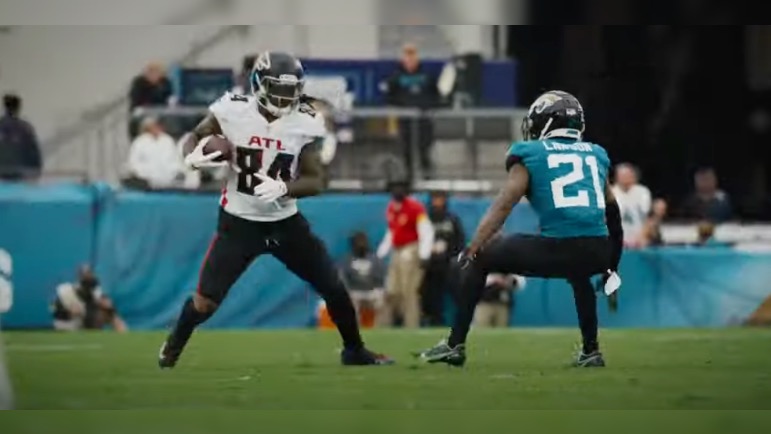For years, kick returners were afterthoughts—like an empty water bottle in a college dorm—just existing, not doing anything. That changed in 2024. For the first time in a while, kick returns could become valuable pieces capable of changing an NFL game. And it’s why the Pittsburgh Steelers signed Cordarrelle Patterson.
I had initially written this article early Tuesday afternoon, wondering who the team would turn to. Before Patterson, there weren’t many obvious or strong options: WRs Quez Watkins and Calvin Austin III topped the list, but neither had much of a resume. But Patterson should top the team’s depth chart, a swift and decisive move by the Steelers.
With the league officially approving a radically different kickoff formation, adopting the XFL style that will align the coverage and return team five yards apart with two kick returners in the “landing zone” in front of the goal line, kick returns should be up this year. And their potential even larger.
While exact impacts are impossible to predict, this is as radical a shift as ever seen with the NFL’s first play. ESPN lays out key details beyond the new formation.
“During the 2024 season, kickers will continue to kick from the 35-yard line, but the other ten players on the kickoff team will line up at the receiving team’s 40-yard line. At least nine members of the return team will line up in a “setup zone” between the 35- and 30-yard lines. Up to two returners can line up in a “landing zone” between the goal line and the 20-yard line.
No one other than the kicker and returner(s) can move until the ball hits the ground or hits a player inside the landing zone. Touchbacks will be marked at the 30-yard line, and no fair catches will be allowed.”
This rule doesn’t apply for onside kicks, though they have to be declared and can only be called in the fourth quarter.
Based on that, here’s the new information that we know.
1. With touchbacks now coming out to the 30 (which was initially proposed to be placed at the 35 before changed), there’s a heavier incentive to kick a returnable ball to pin the opposition deeper than that.
2. There will be two kick returners in the “landing zone” instead of the traditional one with an “up man” used in the post-wedge era who was more of a blocker than a return threat.
3. The coverage and return team will be separated by only five yards, preventing the running start that led to higher rates of head and neck injuries. With more of a one-line wall, the returner could have a higher chance of busting a big return, though I think it’s more debatable than some are giving it credit for (special teams coaches probably still won’t design an all-out attack and have similar contain players on the outside with other potential tweaks).
But the goal is, and it should occur in practice, to have a more robust play that isn’t so touchback-happy. League kick returns have dwindled in recent years, and the league’s “fair catch” policy implemented in 2023, allowing for a fair catch in the field of play to bring the ball out to the 25, kick returns cratered. In 2022, there were 1,013 kick returns. In 2023, there were just 587, a 42 percent decrease.
With the fair catch aspect eliminated and more reason to avoid touchbacks, there should be more returns. Which means needing better return men. Patterson will be one of them but the landing zone requires a second. And what if Patterson gets hurt? Or what about the long-term outlook at the position of the skillset needed for the job?
Last year, they used a little of RB Anthony McFarland Jr. (six returns) and a lot of RB Godwin Igwebuike (11 returns but far more snaps, too). Neither is part of the team’s current roster; McFarland is in the UFL, and Igwebuike is a free agent.
Of the current group to pair next to Cordarrelle Patterson, newly signed WR Quez Watkins could jump to the top of the list. Though he doesn’t have much production experience —just 14 NFL returns with a 14.3-yard average—his 4.35 speed is appealing. Perhaps WR Calvin Austin III will get a look, even if he didn’t return kicks in college. Like Watkins, his speed will pose a threat if he can get past the initial line.
But speed may not be the most important component. Shrine Bowl Director of Football Operations Eric Galko, who worked with the XFL to create the modified kickoff rule the NFL borrowed, pointed out kick returns could evolve into a running play. Vision, break tackle ability, and lateral quickness could become the most important traits.
2. Returner Evaluations: Similar to above, returner value will be less about top end speed and burst, and more about vision and reacting.
In short, more “running back attacking the hole”-type will be more valuable than vs. “receivers navigating in the open field” types.
We at… pic.twitter.com/INEDp8Qocq
— Eric Galko (@EricGalko) March 26, 2024
This could lead to running backs being the team’s choice to serve as kick returners. Cordarrelle Patterson has an all-around skillset but is more of a runner than a receiver. Beyond him on the team, there aren’t many other known options, with Alfonzo Graham injured and carried last season while Aaron Shampkin signed a Reserve/Future deal.
Could there be a Wild Card option? Crazy as it sounds, could former Michigan State RB turned Steelers TE Connor Heyward receive an opportunity? He returned 33 kicks in his first two years of college and has received the occasional carry in Pittsburgh. While unlikely, teams could be mixing and matching and using trial and error this preseason as they figure out what works best.
Like the kicks themselves, kick returners were becoming a ceremonial position. Even when they did field and return the ball, the outcome was generally the same. A short return between the 25 and 30, a formality before the offense took the field. Though Steven Sims came close in 2022, Pittsburgh hasn’t had a kick return touchdown since JuJu Smith-Schuster in the 2017 finale against the Cleveland Browns. It’s a long drought, though they’re hardly alone. Over that span, five other teams don’t have a runback touchdown. The Browns haven’t had one since Josh Cribbs housed three in the 2009 season.
But in an instant, the way this play is thought about has changed. When the NFL makes rule changes, they’re normally around the edges. Visibly, they don’t really impact the way the game looks. This one is different. It is among the most radical changes the league has made, maybe since the early days of football when it took time for the game to evolve from rugby. Throughout the late 1800s, the number of players was reduced, the scoring system routinely updated (there was a time when field goals were worth more than touchdowns, harkening back to those rugby roots), and the down system had to be created along the way (to avoid teams from simply holding onto the ball like the Princeton-Yale “block game” of 1881) along with a host of modifications pioneered by Walter Camp, the Father of American Football.
These kickoff changes aren’t as fundamental, but they will change how teams think and act about the game’s first play. It’s a new world for Special Teams Coordinator Danny Smith and the rest of the NFL. They have their lead man in Cordarrelle Patterson. But that’s just the first step. The scheme, the skillset for the other return man, the skillset of the front line, and juggling how to decide touchbacks versus returns from the end zone, there are lots of layers to just the return aspect without even touching the nuances of the coverage team. There are only a couple of months before this plan is put into action.








